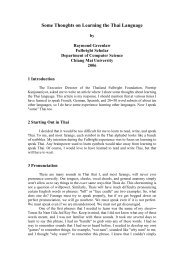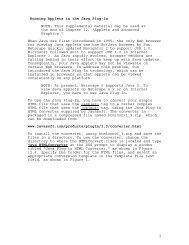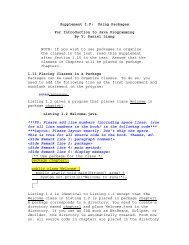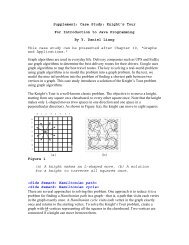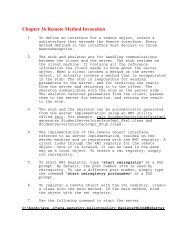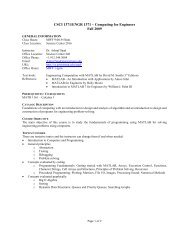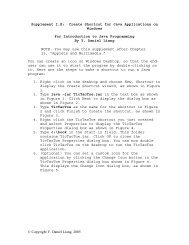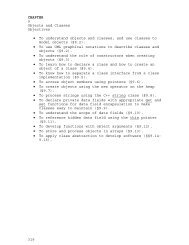CHAPTER 25 Weighted Graphs and Applications Objectives ⢠To ...
CHAPTER 25 Weighted Graphs and Applications Objectives ⢠To ...
CHAPTER 25 Weighted Graphs and Applications Objectives ⢠To ...
You also want an ePaper? Increase the reach of your titles
YUMPU automatically turns print PDFs into web optimized ePapers that Google loves.
<strong>CHAPTER</strong> <strong>25</strong><br />
<strong>Weighted</strong> <strong>Graphs</strong> <strong>and</strong> <strong>Applications</strong><br />
<strong>Objectives</strong><br />
<strong>To</strong> represent weighted edges using adjacency matrices <strong>and</strong> adjacency lists (§<strong>25</strong>.2).<br />
<br />
<strong>To</strong> model weighted graphs using the <strong>Weighted</strong>Graph class that extends the Graph class<br />
(§<strong>25</strong>.3).<br />
<strong>To</strong> design <strong>and</strong> implement the algorithm for finding a minimum spanning tree (§<strong>25</strong>.4).<br />
<strong>To</strong> define the MST class that extends the Tree class (§<strong>25</strong>.4).<br />
<strong>To</strong> design <strong>and</strong> implement the algorithm for finding single-source shortest paths (§<strong>25</strong>.5).<br />
<strong>To</strong> define the ShortestPathTree class that extends the Tree class (§<strong>25</strong>.5).<br />
<strong>To</strong> solve the weighted nine tail problem using the shortest-path algorithm (§<strong>25</strong>.6).<br />
1
<strong>25</strong>.1 Introduction<br />
Key Point: A graph is a weighted graph if each edge is assigned a weight. <strong>Weighted</strong> graphs have<br />
many practical applications.<br />
Figure 24.1 assumes that the graph represents the number of flights among cities. You can apply the BFS to<br />
find the fewest number of flights between two cities. Assume that the edges represent the driving distances<br />
among the cities as shown in Figure <strong>25</strong>.1. How do you find the minimal total distances for connecting all<br />
cities? How do you find the shortest path between two cities? This chapter will address these questions.<br />
The former is known as the minimum spanning tree (MST) problem <strong>and</strong> the latter as the shortest path<br />
problem.<br />
Seattle (0)<br />
807<br />
1331<br />
2097<br />
1003<br />
Chicago (5)<br />
787<br />
983<br />
Boston (6)<br />
214<br />
New York (<br />
San Francisco (1)<br />
1267<br />
1015<br />
Denver (3)<br />
599<br />
533<br />
Kansas Cit y (4)<br />
1260<br />
888<br />
381<br />
1663<br />
864<br />
Los Angeles (2)<br />
1435<br />
496<br />
781<br />
Atlanta (8)<br />
Dallas (10)<br />
239<br />
810<br />
661<br />
Houston (11)<br />
1187<br />
Miami (9)<br />
Figure <strong>25</strong>.1<br />
The graph models the distances among the cities.<br />
The preceding chapter introduced the concept of graphs. You learned how to represent edges using edge<br />
arrays, edge vectors, adjacency matrices, <strong>and</strong> adjacency lists, <strong>and</strong> how to model a graph using the Graph<br />
class. The chapter also introduced two important techniques for traversing graphs: depth-first search <strong>and</strong><br />
breadth-first search, <strong>and</strong> applied traversal to solve practical problems. This chapter will introduce weighted<br />
graphs. You will learn the algorithm for finding a minimum spanning tree in §<strong>25</strong>.4 <strong>and</strong> the algorithm for<br />
finding shortest paths in §<strong>25</strong>.5.<br />
PEDAGOGICAL NOTE<br />
Before we introduce the algorithms <strong>and</strong> applications for weighted graphs, it is helpful to get<br />
2
acquainted with weighted graphs using the GUI interactive tool at<br />
www.cs.armstrong.edu/liang/animation/<strong>Weighted</strong>GraphLearning<strong>To</strong>ol.html. The tool allows you to<br />
enter vertices, specify edges <strong>and</strong> their weights, view the graph, <strong>and</strong> find an MST <strong>and</strong> all shortest<br />
paths from a single source, as shown in Figure <strong>25</strong>.2.<br />
Figure <strong>25</strong>.2<br />
You can use the tool to create a weighted graph with mouse gestures <strong>and</strong> show the MST <strong>and</strong> shortest paths.<br />
<strong>25</strong>.2 Representing <strong>Weighted</strong> <strong>Graphs</strong><br />
Key Point: <strong>Weighted</strong> edges can be stored in adjacency lists.<br />
There are two types of weighted graphs: vertex weighted <strong>and</strong> edge weighted. In a vertex-weighted graph,<br />
each vertex is assigned a weight. In an edge-weighted graph, each edge is assigned a weight. Of the two<br />
types, edge-weighted graphs have more applications. This chapter considers edge-weighted graphs.<br />
<strong>Weighted</strong> graphs can be represented in the same way as unweighted graphs, except that you have to<br />
represent the weights on the edges. As with unweighted graphs, the vertices in weighted graphs can be<br />
stored in an array. This section introduces three representations for the edges in weighted graphs.<br />
3
<strong>25</strong>.2.1 Representing <strong>Weighted</strong> Edges: Edge Array<br />
<strong>Weighted</strong> edges can be represented using a two-dimensional array. For example, you can store all the edges<br />
in the graph in Figure <strong>25</strong>.3 using the following array:<br />
int edges[][3] =<br />
{<br />
{0, 1, 2}, {0, 3, 8},<br />
{1, 0, 2}, {1, 2, 7}, {1, 3, 3},<br />
{2, 1, 7}, {2, 3, 4}, {2, 4, 5},<br />
{3, 0, 8}, {3, 1, 3}, {3, 2, 4}, {3, 4, 6},<br />
{4, 2, 5}, {4, 3, 6}<br />
};<br />
1<br />
7<br />
2<br />
2<br />
8<br />
3<br />
4<br />
6<br />
5<br />
0<br />
3 4<br />
Figure <strong>25</strong>.3<br />
Each edge is assigned a weight on an edge-weighted graph.<br />
NOTE<br />
For simplicity, we assume that the weights are integers.<br />
<strong>25</strong>.2.2 <strong>Weighted</strong> Adjacency Lists<br />
Another way to represent the edges is to define edges as objects. The Edge class was defined to represent<br />
edges in unweighted graphs. For weighted edges, we define the <strong>Weighted</strong>Edge class as shown in Listing<br />
<strong>25</strong>.1.<br />
Listing <strong>25</strong>.1 <strong>Weighted</strong>Edge.cpp<br />
1 #ifndef WEIGHTEDEDGE_H<br />
2 #define WEIGHTEDEDGE_H<br />
3<br />
4 #include "Edge.h"<br />
5<br />
6 class <strong>Weighted</strong>Edge : public Edge<br />
4
7 {<br />
8 public:<br />
9 double weight; // The weight on edge (u, v)<br />
10<br />
11 // Create a weighted edge on (u, v)<br />
12 <strong>Weighted</strong>Edge(int u, int v, double weight): Edge(u, v)<br />
13 {<br />
14 this->weight = weight;<br />
15 }<br />
16<br />
17 // Compare edges based on weights<br />
18 bool operator=(const <strong>Weighted</strong>Edge& edge) const<br />
34 {<br />
35 return (*this).weight >= edge.weight;<br />
36 }<br />
37<br />
38 bool operator==(const <strong>Weighted</strong>Edge& edge) const<br />
39 {<br />
40 return (*this).weight == edge.weight;<br />
41 }<br />
42<br />
43 bool operator!=(const <strong>Weighted</strong>Edge& edge) const<br />
44 {<br />
45 return (*this).weight != edge.weight;<br />
46 }<br />
47 };<br />
48 #endif<br />
The Edge class, defined in Listing 24.1, represents an edge from vertex u to v. <strong>Weighted</strong>Edge extends<br />
Edge with a new property weight.<br />
<strong>To</strong> create a <strong>Weighted</strong>Edge object, use WeighedEdge(i, j, w), where w is the weight on edge (i,<br />
j). Often you need to compare the weights of the edges. For this reason, we define the operator functions<br />
(=) in the <strong>Weighted</strong>Edge class.<br />
5
For unweighted graphs, we use adjacency edge lists to represent edges. For weighted graphs, we still use<br />
adjacency edge lists. Since <strong>Weighted</strong>Edge is derived from Edge. The adjacency edge list for<br />
unweighted graphs can be used for weighted graphs. For example, the adjacency edge lists for the vertices<br />
in the graph in Figure <strong>25</strong>.3 can be represented as follows:<br />
vector neighbors;<br />
for (unsigned i = 0; i < numberOfVertices; i++)<br />
{<br />
neighbors.push_back(vector());<br />
}<br />
neighbors[0].push_back(new <strong>Weighted</strong>Edge(0, 1, 2));<br />
neighbors[0].push_back(new <strong>Weighted</strong>Edge(0, 3, 8));<br />
...<br />
wNeighbors[0]<br />
wNeighbors[1]<br />
wNeighbors[2]<br />
wNeighbors[3]<br />
wNeighbors[4]<br />
<strong>Weighted</strong>Edge(0, 1, 2) <strong>Weighted</strong>Edge(0, 3, 8)<br />
<strong>Weighted</strong>Edge(1, 0, 2) <strong>Weighted</strong>Edge(1, 3, 3) <strong>Weighted</strong>Edge(1, 2, 7)<br />
<strong>Weighted</strong>Edge(2, 3, 4) <strong>Weighted</strong>Edge(2, 4, 5) <strong>Weighted</strong>Edge(2, 1, 7)<br />
<strong>Weighted</strong>Edge(3, 1, 3) <strong>Weighted</strong>Edge(3, 2, 4) <strong>Weighted</strong>Edge(3, 4, 6) <strong>Weighted</strong>Edge(3, 0, 8)<br />
<strong>Weighted</strong>Edge(4, 2, 5) <strong>Weighted</strong>Edge(4, 3, 6)<br />
Check point<br />
<strong>25</strong>.1 For the code <strong>Weighted</strong>Edge edge(1, 2, 3.5), what is edge.u, edge.v, <strong>and</strong><br />
edge.weight?<br />
<strong>25</strong>.2 What is the output of the following code?<br />
vector list;<br />
list.push_back(<strong>Weighted</strong>Edge(1, 2, 3.5));<br />
list.push_back(<strong>Weighted</strong>Edge(2, 3, 5.5));<br />
list.push_back(<strong>Weighted</strong>Edge(4, 3, 4.5));<br />
cout weight
Graph<br />
Defined in Figure 24.7.<br />
<strong>Weighted</strong>Graph<br />
+<strong>Weighted</strong>Graph()<br />
+<strong>Weighted</strong>Graph(vertices: vector&, edges:<br />
vector&)<br />
+<strong>Weighted</strong>Graph(numberOfVertices: int, edges:<br />
vector&)<br />
+print<strong>Weighted</strong>Edges(): void const<br />
+getMinimumSpanningTree(): MST const<br />
+getMinimumSpanningTree(v: int): MST const<br />
+getShortestPath(v: int): ShortestPathTree const<br />
+addEdges(u: int, v: int, weigh t: double): b ool<br />
Constructs an empty <strong>Weighted</strong>Graph.<br />
Constructs a Wei ghtedGraph wit h the speci fi ed verti ces <strong>and</strong><br />
edges in vectors.<br />
Constructs a <strong>Weighted</strong>Graph with vertices 0, 1, …, n–1, <strong>and</strong><br />
edges in a vector.<br />
Displays all edges <strong>and</strong> weights.<br />
Returns a min imum spanning tree starting from vertex 0.<br />
Returns a min imum spanning tree starting from vertex v.<br />
Returns all single-source shortes t paths.<br />
Adds a wei ghted edge t o the grap h <strong>and</strong> throws an<br />
invalid_argument if u, v, or w is invalid. Return s false if<br />
(u, v) is already in the graph.<br />
Figure <strong>25</strong>.4<br />
<strong>Weighted</strong>Graph extends Graph.<br />
<strong>Weighted</strong>Graph simply extends Graph. <strong>Weighted</strong>Graph inherits all functions from Graph <strong>and</strong> also<br />
introduces the new functions for obtaining minimum spanning trees <strong>and</strong> for finding single-source all<br />
shortest paths. Minimum spanning trees <strong>and</strong> shortest paths will be introduced in §<strong>25</strong>.4 <strong>and</strong> §<strong>25</strong>.5,<br />
respectively.<br />
The class contains three constructors. The first is a no-arg constructor to create an empty graph. The second<br />
constructs a <strong>Weighted</strong>Graph with the specified vertices <strong>and</strong> edges in vectors. The third constructs a<br />
<strong>Weighted</strong>Graph with vertices 0, 1, ..., n-1 <strong>and</strong> an edge vector. The print<strong>Weighted</strong>Edges function<br />
displays all edges for each vertex. Listing <strong>25</strong>.2 implements <strong>Weighted</strong>Graph.<br />
Listing <strong>25</strong>.2 <strong>Weighted</strong>Graph.h<br />
1 #ifndef WEIGHTEDGRAPH_H<br />
2 #define WEIGHTEDGRAPH_H<br />
3<br />
4 #include "Graph.h"<br />
5 #include "<strong>Weighted</strong>Edge.h" // Defined in Listing <strong>25</strong>.1<br />
6 #include "MST.h" // Defined in Listing <strong>25</strong>.3<br />
7 #include "ShortestPathTree.h" // Defined in Listing <strong>25</strong>.8<br />
8<br />
9 template<br />
10 class <strong>Weighted</strong>Graph : public Graph<br />
11 {<br />
12 public:<br />
7
8<br />
13 // Construct an empty graph<br />
14 <strong>Weighted</strong>Graph();<br />
15<br />
16 // Construct a graph from vertices <strong>and</strong> edges objects<br />
17 <strong>Weighted</strong>Graph(vector& vertices, vector& edges);<br />
18<br />
19 // Construct a graph with vertices 0, 1, ..., n-1 <strong>and</strong><br />
20 // edges in a vector<br />
21 <strong>Weighted</strong>Graph(int numberOfVertices, vector& edges);<br />
22<br />
23 // Print all edges in the weighted tree<br />
24 void <strong>Weighted</strong>Graph::print<strong>Weighted</strong>Edges();<br />
<strong>25</strong><br />
26 // Add a weighted edge<br />
27 bool addEdge(int u, int v, double w);<br />
28<br />
29 // Get a minimum spanning tree rooted at vertex 0<br />
30 MST getMinimumSpanningTree();<br />
31<br />
32 // Get a minimum spanning tree rooted at a specified vertex<br />
33 MST getMinimumSpanningTree(int startingVertex);<br />
34<br />
35 // Find single-source shortest paths<br />
36 ShortestPathTree getShortestPath(int sourceVertex);<br />
37 };<br />
38<br />
39 const int INFINITY = 2147483647;<br />
40<br />
41 template<br />
42 <strong>Weighted</strong>Graph::<strong>Weighted</strong>Graph()<br />
43 {<br />
44 }<br />
45<br />
46 template<br />
47 <strong>Weighted</strong>Graph::<strong>Weighted</strong>Graph(vector& vertices,<br />
48 vector& edges)<br />
49 {<br />
50 // Add vertices to the graph<br />
51 for (unsigned i = 0; i < vertices.size(); i++)<br />
52 {<br />
53 addVertex(vertices[i]);<br />
54 }<br />
55<br />
56 // Add edges to the graph<br />
57 for (unsigned i = 0; i < edges.size(); i++)<br />
58 {<br />
59 addEdge(edges[i].u, edges[i].v, edges[i].weight);<br />
60 }<br />
61 }<br />
62<br />
63 template<br />
64 <strong>Weighted</strong>Graph::<strong>Weighted</strong>Graph(int numberOfVertices,<br />
65 vector& edges)<br />
66 {<br />
67 // Add vertices to the graph<br />
68 for (int i = 0; i < numberOfVertices; i++)<br />
69 addVertex(i); // vertices is {0, 1, 2, ..., n-1}<br />
70<br />
71 // Add edges to the graph
72 for (unsigned i = 0; i < edges.size(); i++)<br />
73 {<br />
74 addEdge(edges[i].u, edges[i].v, edges[i].weight);<br />
75 }<br />
76 }<br />
77<br />
78 template<br />
79 void <strong>Weighted</strong>Graph::print<strong>Weighted</strong>Edges()<br />
80 {<br />
81 for (int i = 0; i < getSize(); i++)<br />
82 {<br />
83 // Display all edges adjacent to vertex with index i<br />
84 cout
131 for (int i = 0; i < getSize(); i++)<br />
132 {<br />
133 if (find(T.begin(), T.end(), i)== T.end()<br />
134 && cost[i] < currentMinCost)<br />
135 {<br />
136 currentMinCost = cost[i];<br />
137 u = i;<br />
138 }<br />
139 }<br />
140<br />
141 T.push_back(u); // Add a new vertex to T<br />
142 totalWeight += cost[u]; // Add cost[u] to the tree<br />
143<br />
144 // Adjust cost[v] for v that is adjacent to u <strong>and</strong> v in V - T<br />
145 for (Edge* e: neighbors[u])<br />
146 {<br />
147 if (find(T.begin(), T.end(), e->v) == T.end()<br />
148 && cost[e->v] > static_cast(e)->weight)<br />
149 {<br />
150 cost[e->v] = static_cast(e)->weight;<br />
151 parent[e->v] = u;<br />
152 }<br />
153 }<br />
154 } // End of while<br />
155<br />
156 return MST(startingVertex, parent, T, totalWeight);<br />
157 }<br />
158<br />
159 template<br />
160 ShortestPathTree <strong>Weighted</strong>Graph::getShortestPath(int<br />
sourceVertex)<br />
161 {<br />
162 // T stores the vertices whose path found so far<br />
163 vector T;<br />
164<br />
165 // parent[v] stores the previous vertex of v in the path<br />
166 vector parent(getSize());<br />
167 parent[sourceVertex] = -1; // The parent of source is set to -1<br />
168<br />
169 // cost[v] stores the cost of the path from v to the source<br />
170 vector cost(getSize());<br />
171 for (unsigned i = 0; i < cost.size(); i++)<br />
172 {<br />
173 cost[i] = INFINITY; // Initial cost set to infinity<br />
174 }<br />
175 cost[sourceVertex] = 0; // Cost of source is 0<br />
176<br />
177 // Exp<strong>and</strong> T<br />
178 while (T.size() < getSize())<br />
179 {<br />
180 // Find smallest cost v in V - T<br />
181 int u = -1; // Vertex to be determined<br />
182 double currentMinCost = INFINITY;<br />
183 for (int i = 0; i < getSize(); i++)<br />
184 {<br />
185 if (find(T.begin(), T.end(), i)== T.end()<br />
186 && cost[i] < currentMinCost)<br />
187 {<br />
188 currentMinCost = cost[i];<br />
10
189 u = i;<br />
190 }<br />
191 }<br />
192<br />
193 if (u == -1) break;<br />
194<br />
195 T.push_back(u); // Add a new vertex to T<br />
196<br />
197 // Adjust cost[v] for v that is adjacent to u <strong>and</strong> v in V - T<br />
198 for (Edge* e: neighbors[u])<br />
199 {<br />
200 if (find(T.begin(), T.end(), e->v) == T.end() &&<br />
201 cost[e->v] > cost[u] + static_cast(e)-<br />
>weight)<br />
202 {<br />
203 cost[e->v] = cost[u] + static_cast(e)-<br />
>weight;<br />
204 parent[e->v] = u;<br />
205 }<br />
206 }<br />
207 } // End of while<br />
208<br />
209 // Create a ShortestPathTree<br />
210 return ShortestPathTree(sourceVertex, parent, T, cost);<br />
211 }<br />
212<br />
213 #endif<br />
<strong>Weighted</strong>Graph is derived from Graph (line 10). The properties vertices<br />
<strong>and</strong> neighbors are defined as protected in the parent class Graph, so<br />
they can be accessed in the child class <strong>Weighted</strong>Graph.<br />
When a <strong>Weighted</strong>Graph is constructed, its vertices <strong>and</strong> adjacency edge<br />
lists are created by invoking the addVertex function (lines 56, 72) <strong>and</strong><br />
the addEdge function (lines 62, 77). The addVertex function is defined<br />
the Graph class in Listing 24.3. The addEdge function invokes the<br />
createEdge function to add a weighted edge to the graph (lines 96-100).<br />
The createEdge function is defined as protected in Listing 24.3<br />
Graph.h. This function checks whether the edge is valid <strong>and</strong> throws an<br />
invalid_argument exception if the edge is invalid.<br />
Listing <strong>25</strong>.3 gives a test program that creates a graph for the one in<br />
Figure <strong>25</strong>.1 <strong>and</strong> another graph for the one in Figure <strong>25</strong>.3.<br />
Listing <strong>25</strong>.3 Test<strong>Weighted</strong>Graph.cpp<br />
1 #include <br />
2 #include <br />
3 #include <br />
4 #include "<strong>Weighted</strong>Graph.h"<br />
5 #include "<strong>Weighted</strong>Edge.h"<br />
6 using namespace std;<br />
7<br />
8 int main()<br />
9 {<br />
10 // Vertices for graph in Figure <strong>25</strong>.1<br />
11 string vertices[] = {"Seattle", "San Francisco", "Los Angeles",<br />
12 "Denver", "Kansas City", "Chicago", "Boston", "New York",<br />
11
13 "Atlanta", "Miami", "Dallas", "Houston"};<br />
14<br />
15 // Edge array for graph in Figure <strong>25</strong>.1<br />
16 int edges[][3] = {<br />
17 {0, 1, 807}, {0, 3, 1331}, {0, 5, 2097},<br />
18 {1, 0, 807}, {1, 2, 381}, {1, 3, 1267},<br />
19 {2, 1, 381}, {2, 3, 1015}, {2, 4, 1663}, {2, 10, 1435},<br />
20 {3, 0, 1331}, {3, 1, 1267}, {3, 2, 1015}, {3, 4, 599},<br />
21 {3, 5, 1003},<br />
22 {4, 2, 1663}, {4, 3, 599}, {4, 5, 533}, {4, 7, 1260},<br />
23 {4, 8, 864}, {4, 10, 496},<br />
24 {5, 0, 2097}, {5, 3, 1003}, {5, 4, 533},<br />
<strong>25</strong> {5, 6, 983}, {5, 7, 787},<br />
26 {6, 5, 983}, {6, 7, 214},<br />
27 {7, 4, 1260}, {7, 5, 787}, {7, 6, 214}, {7, 8, 888},<br />
28 {8, 4, 864}, {8, 7, 888}, {8, 9, 661},<br />
29 {8, 10, 781}, {8, 11, 810},<br />
30 {9, 8, 661}, {9, 11, 1187},<br />
31 {10, 2, 1435}, {10, 4, 496}, {10, 8, 781}, {10, 11, 239},<br />
32 {11, 8, 810}, {11, 9, 1187}, {11, 10, 239}<br />
33 };<br />
34<br />
35 // 23 undirected edges in Figure <strong>25</strong>.1<br />
36 const int NUMBER_OF_EDGES = 46;<br />
37<br />
38 // Create a vector for vertices<br />
39 vector vectorOfVertices(12);<br />
40 copy(vertices, vertices + 12, vectorOfVertices.begin());<br />
41<br />
42 // Create a vector for edges<br />
43 vector edgeVector;<br />
44 for (int i = 0; i < NUMBER_OF_EDGES; i++)<br />
45 edgeVector.push_back(<strong>Weighted</strong>Edge(edges[i][0],<br />
46 edges[i][1], edges[i][2]));<br />
47<br />
48 <strong>Weighted</strong>Graph graph1(vectorOfVertices, edgeVector);<br />
49 cout
72 edges2[i][1], edges2[i][2]));<br />
73<br />
74 <strong>Weighted</strong>Graph graph2(5, edgeVector2); // 5 vertices in<br />
graph2<br />
75<br />
76 cout
2097 (edges[2][2]). <strong>To</strong> create a <strong>Weighted</strong>Graph, you have to obtain a vector of <strong>Weighted</strong>Edge<br />
(lines 41–44).<br />
Line 52 invokes the print<strong>Weighted</strong>Edges() function on graph1 to display all edges in graph1.<br />
The program creates a <strong>Weighted</strong>Graph graph2 for the graph in Figure <strong>25</strong>.3 in lines 55–71. Line 75<br />
invokes the print<strong>Weighted</strong>Edges() function on graph2 to display all edges in graph2.<br />
Check point<br />
<strong>25</strong>.3 What is the output of the following code?<br />
vector list;<br />
list.push_back(<strong>Weighted</strong>Edge(1, 2, 3.5));<br />
list.push_back(<strong>Weighted</strong>Edge(1, 6, 6.5));<br />
list.push_back(<strong>Weighted</strong>Edge(1, 7, 1.5));<br />
cout
vector neighbors;<br />
neighbors[0].push_back(<strong>Weighted</strong>Edge(0, 2, 3.5));<br />
neighbors[0].push_back(<strong>Weighted</strong>Edge(0, 6, 6.5));<br />
neighbors[0].push_back(<strong>Weighted</strong>Edge(0, 7, 1.5));<br />
neighbors[1].push_back(<strong>Weighted</strong>Edge(1, 0, 3.5));<br />
neighbors[1].push_back(<strong>Weighted</strong>Edge(1, 5, 8.5));<br />
neighbors[1].push_back(<strong>Weighted</strong>Edge(1, 8, 19.5));<br />
cout
Figure <strong>25</strong>.5<br />
The tree in (c) <strong>and</strong> (d) are minimum spanning trees of the graph in (a).<br />
The problem of finding a minimum spanning tree has many applications. Consider a company with<br />
branches in many cities. The company wants to lease telephone lines to connect all branches together. The<br />
phone company charges different amounts of money to connect different pairs of cities. There are many<br />
ways to connect all branches together. The cheapest way is to find a spanning tree with the minimum total<br />
rates.<br />
<strong>25</strong>.4.1 Minimum Spanning Tree Algorithms<br />
How do you find a minimum spanning tree? There are several well-known algorithms for doing so. This<br />
section introduces Prim’s algorithm. Prim’s algorithm starts with a spanning tree T that contains an<br />
arbitrary vertex. The algorithm exp<strong>and</strong>s the tree by adding a vertex with the smallest edge incident to a<br />
vertex already in the tree. The algorithm is described in Listing <strong>25</strong>.4.<br />
Listing <strong>25</strong>.4 Prim’s Minimum Spanning Tree Algorithm<br />
Input: A connected undirected weighted G = (V, E)<br />
Output: MST (a minimum spanning tree)<br />
1 MST minimumSpanningTree()<br />
2 {<br />
3 Let T be a set for the vertices in the spanning tree;<br />
4 Set cost[v] = infinity for each vertex v;<br />
5 Pick an arbitrary vertex, say s <strong>and</strong> set cost[s] = 0 <strong>and</strong> parent[s]<br />
= -1;<br />
6<br />
7 while (size of T < n)<br />
8 {<br />
9 Find u not in T with the smallest cost[u];<br />
16
10 Add u to T;<br />
11 for (each v not in T <strong>and</strong> (u, v) in E)<br />
12 {<br />
13 if (cost[v] > w(u, v))<br />
14 cost[v] = w(u, v); parent[v] = u;<br />
15 }<br />
16 }<br />
The algorithm starts by selecting an arbitrary vertex s <strong>and</strong> assign 0 to cost[s] (line 5) <strong>and</strong> infinity to cost[v]<br />
for all other vertices (line 4). It then adds s into T during the first iteration of the while loop (lines 7-16).<br />
After s is added into T, adjust cost[v] for each v adjacent to s. cost[v] is the smallest weight among all v’s<br />
edges that are adjacent to a vertex in T. If cost[v] is infinity, it indicates that v is not adjacent to any vertex<br />
in T at the moment. In each subsequent iteration of the while loop, the vertex u with the smallest cost[u] is<br />
picked <strong>and</strong> added into T (lines 9-10), as shown in Figure <strong>25</strong>.6a. Afterwards, cost[v] is updated to w(u, v)<br />
<strong>and</strong> parent[v] to u for each v in V-T <strong>and</strong> v is adjacent to u if cost[v] > w(u, v) (lines 13-14), as shown in<br />
Figure <strong>25</strong>.6b. Here, w(u, v) denotes the weight on edge (u, v).<br />
Figure <strong>25</strong>.6<br />
(a) Find a vertex u in V – T with the smallest cost[u]. (b) Update cost[v] for v in V – T <strong>and</strong> v is adjacent to<br />
u.<br />
V - T<br />
V - T<br />
T<br />
u<br />
v1<br />
T<br />
v1<br />
s<br />
v2<br />
v3<br />
s<br />
u<br />
v2<br />
v3<br />
T cont ai ns vertices i n the<br />
spanning tree<br />
V- T contai ns vertices currently not in<br />
the spanning tree. cost[v] stores the<br />
smallest edge weight to a vertex in T.<br />
T contains vertices in the<br />
spanning tree.<br />
V- T contai ns vertices currently not in<br />
the spanning tree. cost[v] stores the<br />
smallest edge weight to a vertex in T.<br />
(a) Before moving u to T<br />
(b) After moving u to T<br />
17
Consider the graph in Figure <strong>25</strong>.7a. Suppose the algorithm selects 0 <strong>and</strong> assigns cost[0] = 0 <strong>and</strong> parent[0]<br />
= -1. The algorithm adds the vertices to T in this order:<br />
1. Add vertex 0 to T <strong>and</strong> set cost[1], parent[1], cost[5], <strong>and</strong> parent[5], as shown in Figure <strong>25</strong>.7b<br />
2. Add vertex 5 to T, since cost[5] is the smallest. Update the cost <strong>and</strong> parent values for vertices 1, 6,<br />
<strong>and</strong> 4, as shown in Figure <strong>25</strong>.7c.<br />
3. cost[1] <strong>and</strong> cost[6] are now the smallest in V-T. Pick either, say vertex 1. Add vertex 1 to T.<br />
Update the cost <strong>and</strong> parent for the adjacent vertices of 1 if applicable, as shown in Figure <strong>25</strong>.7d.<br />
4. Add vertex 6 to T, since cost[6] has the smallest weight among all edges adjacent to the vertices in<br />
T. Update the cost <strong>and</strong> parent for the adjacent vertices of 6 if applicable, as shown in Figure <strong>25</strong>.7e.<br />
5. Add vertex 4 to T, since cost[4] has the smallest weight among all edges adjacent to the vertices in<br />
T. Update the cost <strong>and</strong> parent for the adjacent vertices of 4 if applicable, as shown in Figure <strong>25</strong>.7f.<br />
6. Add vertex 2 to T, since cost[2] has the smallest weight among all edges adjacent to the vertices in<br />
T, as shown in Figure <strong>25</strong>.7e.<br />
7. Since 3 is the only vertex in V-T, add vertex 3 to T, as shown in Figure <strong>25</strong>.7f.<br />
Figure <strong>25</strong>.7<br />
The adjacent vertices with the smallest weight are added successively to T.<br />
0<br />
9<br />
5<br />
2<br />
1<br />
10<br />
7 5<br />
6<br />
2 1<br />
1<br />
2<br />
8<br />
8<br />
3<br />
cost<br />
0<br />
0 1 2 3 4 5 6<br />
parent<br />
-1<br />
T<br />
5 12 4<br />
0 1 2 3 4 5 6<br />
(a)<br />
18
1 10 2<br />
cost<br />
0 9 5<br />
9<br />
7 5<br />
8<br />
T 0 1 2 3 4 5 6<br />
0 2 6 1<br />
3<br />
parent<br />
5<br />
2 1<br />
8<br />
-1 0 0<br />
T<br />
5 12 4<br />
0 1 2 3 4 5 6<br />
(b)<br />
1 10 2<br />
cost<br />
0 2 12 5 2<br />
9<br />
7 5<br />
8<br />
T 0 1 2 3 4 5 6<br />
0 2 6 1<br />
3<br />
parent<br />
5<br />
2 1<br />
8<br />
-1 5 5 0 5<br />
T<br />
5 12 4<br />
0 1 2 3 4 5 6<br />
(c)<br />
0<br />
T<br />
5<br />
9<br />
2<br />
1<br />
10<br />
7 5<br />
6<br />
2 1<br />
1<br />
2<br />
8<br />
8<br />
3<br />
cost<br />
0 2 10 12 5 2<br />
0 1 2 3 4 5 6<br />
parent<br />
-1 5 1 5 0 5<br />
T<br />
5 12 4<br />
0 1 2 3 4 5 6<br />
(d)<br />
19
0<br />
T<br />
5<br />
9<br />
2<br />
1<br />
10<br />
7 5<br />
6<br />
2 1<br />
1<br />
2<br />
8<br />
8<br />
3<br />
cost<br />
0 2 10 1 5 2<br />
0 1 2 3 4 5 6<br />
parent<br />
-1 5 1 6 0 5<br />
T<br />
5 12 4<br />
0 1 2 3 4 5 6<br />
(e)<br />
0<br />
T<br />
5<br />
9<br />
2<br />
1<br />
10<br />
7 5<br />
6<br />
2 1<br />
1<br />
2<br />
8<br />
8<br />
3<br />
cost<br />
0 2 1 8 1 5 2<br />
0 1 2 3 4 5 6<br />
parent<br />
-1 5 4 4 6 0 5<br />
5 12 4<br />
0 1 2 3 4 5 6<br />
(e)<br />
0<br />
T<br />
5<br />
9<br />
2<br />
1<br />
10<br />
7 5<br />
6<br />
2 1<br />
1<br />
2<br />
8<br />
8<br />
3<br />
cost<br />
0 2 1 8 1 5 2<br />
0 1 2 3 4 5 6<br />
parent<br />
-1 5 4 4 6 0 5<br />
5 12 4<br />
0 1 2 3 4 5 6<br />
(f)<br />
0<br />
T<br />
5<br />
9<br />
2<br />
1<br />
10<br />
7 5<br />
6<br />
2 1<br />
1<br />
2<br />
8<br />
8<br />
3<br />
cost<br />
0 2 1 8 1 5 2<br />
0 1 2 3 4 5 6<br />
parent<br />
-1 5 4 4 6 0 5<br />
5 12 4<br />
0 1 2 3 4 5 6<br />
20
(g)<br />
NOTE:<br />
A minimum spanning tree is not unique. For example, both Figure <strong>25</strong>.5c <strong>and</strong> Figure<br />
<strong>25</strong>.5d are minimum spanning trees for the graph in Figure <strong>25</strong>.7a. However, if the<br />
weights are distinct, the graph has a unique minimum spanning tree.<br />
NOTE:<br />
Assume that the graph is connected <strong>and</strong> undirected. If a graph is not connected or<br />
directed, the program may not work. You may modify the program to find a spanning<br />
forest for any undirected graph.<br />
The getMinimumSpanningTree(int v) function is defined in the <strong>Weighted</strong>Graph class. It returns an<br />
instance of the MST class. The MST class is defined as a child class of Tree, as shown in Figure <strong>25</strong>.8. The<br />
Tree class was defined in Listing 24.4. Listing <strong>25</strong>.5 implements the MST class.<br />
Tree<br />
Defined in Figure 24.8.<br />
MST<br />
-totalWeight: double<br />
+MST()<br />
+MST(root: int, parent: vector&, searchOrders:<br />
vector&, totalWeight: double)<br />
+get<strong>To</strong>talWeight(): double<br />
<strong>To</strong>tal weight of the tree.<br />
Constructs an empty MST.<br />
Constructs an MST with the specified root, parent vector,<br />
search order vector, <strong>and</strong> total weight for the tree.<br />
Returns the totalWeight of the tree.<br />
Figure <strong>25</strong>.8<br />
The MST class extends the Tree class.<br />
Listing <strong>25</strong>.5 MST.h<br />
1 #ifndef MST_H<br />
2 #define MST_H<br />
21
3<br />
4 #include "Tree.h" // Defined in Listing 24.4<br />
5<br />
6 class MST : public Tree<br />
7 {<br />
8 public:<br />
9 // Create an empty MST<br />
10 MST()<br />
11 {<br />
12 }<br />
13<br />
14 // Construct a tree with root, parent, searchOrders,<br />
15 // <strong>and</strong> total weight<br />
16 MST(int root, vector& parent, vector& searchOrders,<br />
17 double totalWeight) : Tree(root, parent, searchOrders)<br />
18 {<br />
19 this->totalWeight = totalWeight;<br />
20 }<br />
21<br />
22 // Return the total weight of the tree<br />
23 double get<strong>To</strong>talWeight()<br />
24 {<br />
<strong>25</strong> return totalWeight;<br />
26 }<br />
27<br />
28 private:<br />
29 double totalWeight;<br />
30 };<br />
31 #endif<br />
The getMinimumSpanningTree function was implemented in lines 127–185 in Listing <strong>25</strong>.2. The<br />
getMinimumSpanningTree() function picks vertex 0 as the starting vertex <strong>and</strong> invokes the<br />
getMinimumSpanningTree(0) function to return the MST starting from 0 (line 130).<br />
The getMinimumSpanningTree(startingVertex) function sets cost[startingVertex] to 0 (line<br />
150) <strong>and</strong> cost[v] to infinity for all other vertices (lines 146-149). It then repeatedly finds the vertex with the<br />
smallest cost in V-T (lines 156-166) <strong>and</strong> adds it to T (lines 168. After a vertex u is added to T, the cost <strong>and</strong><br />
parent for each vertex v in V-T adjacent to u may be adjusted (lines 171-182).<br />
After a new vertex is added to T (line 193), totalWeight is updated (line 169). Once all vertices are<br />
added to T, an instance of MST is created (line 184).<br />
22
The MST class extends the Tree class. <strong>To</strong> create an instance of MST, pass root, parent,<br />
searchOrders, <strong>and</strong> totalWeight (lines 200). The data fields root, parent, <strong>and</strong> searchOrders<br />
are defined in the Tree class.<br />
Since T is a vector, testing whether a vertex k is in T by invoking the STL find algorithm (line 168)<br />
takes O(n) time. The testing time can be reduced to O(1) by introducing an array, say isInT, to track<br />
whether a vertex k is in T. Whenever a vertex k is added to T, set isInT[k] to true. See Programming<br />
Exercise <strong>25</strong>.11 for implementing the algorithm using isInT. So, the total time for finding the vertex to be<br />
added into T is O(|V| 2 ). Every time after a vertex u is added into T, the function updates cost[v] <strong>and</strong><br />
parent[v] for each vertex v adjacent to u <strong>and</strong> for v in V-T. vertex v’s cost <strong>and</strong> parent are updated if<br />
cost[v] > w(u, v). Each edge incident to u is examined only once. So the total time for examining<br />
the edges is O(|E|). Therefore the time complexity of this implementation is O(|V| 2 +|E|)=O(|V| 2 ). Using<br />
priority queues, we can implement the algorithm in O(|E|log|V|) time (see Programming Exercise <strong>25</strong>.9),<br />
which is more efficient for sparse graphs.<br />
Listing <strong>25</strong>.6 gives a test program that displays minimum spanning trees for the graph in Figure <strong>25</strong>.1 <strong>and</strong><br />
the graph in Figure <strong>25</strong>.3, respectively.<br />
Listing <strong>25</strong>.6 TestMinimumSpanningTree.cpp<br />
1 #include <br />
2 #include <br />
3 #include <br />
4 #include "<strong>Weighted</strong>Graph.h" // Defined in Listing <strong>25</strong>.2<br />
5 #include "<strong>Weighted</strong>Edge.h" // Defined in Listing <strong>25</strong>.1<br />
6 using namespace std;<br />
7<br />
8 // Print tree<br />
9 template<br />
10 void printTree(Tree& tree, vector& vertices)<br />
11 {<br />
12 cout
22<br />
23 int main()<br />
24 {<br />
<strong>25</strong> // Vertices for graph in Figure <strong>25</strong>.1<br />
26 string vertices[] = {"Seattle", "San Francisco", "Los Angeles",<br />
27 "Denver", "Kansas City", "Chicago", "Boston", "New York",<br />
28 "Atlanta", "Miami", "Dallas", "Houston"};<br />
29<br />
30 // Edge array for graph in Figure <strong>25</strong>.1<br />
31 int edges[][3] = {<br />
32 {0, 1, 807}, {0, 3, 1331}, {0, 5, 2097},<br />
33 {1, 0, 807}, {1, 2, 381}, {1, 3, 1267},<br />
34 {2, 1, 381}, {2, 3, 1015}, {2, 4, 1663}, {2, 10, 1435},<br />
35 {3, 0, 1331}, {3, 1, 1267}, {3, 2, 1015}, {3, 4, 599},<br />
36 {3, 5, 1003},<br />
37 {4, 2, 1663}, {4, 3, 599}, {4, 5, 533}, {4, 7, 1260},<br />
38 {4, 8, 864}, {4, 10, 496},<br />
39 {5, 0, 2097}, {5, 3, 1003}, {5, 4, 533},<br />
40 {5, 6, 983}, {5, 7, 787},<br />
41 {6, 5, 983}, {6, 7, 214},<br />
42 {7, 4, 1260}, {7, 5, 787}, {7, 6, 214}, {7, 8, 888},<br />
43 {8, 4, 864}, {8, 7, 888}, {8, 9, 661},<br />
44 {8, 10, 781}, {8, 11, 810},<br />
45 {9, 8, 661}, {9, 11, 1187},<br />
46 {10, 2, 1435}, {10, 4, 496}, {10, 8, 781}, {10, 11, 239},<br />
47 {11, 8, 810}, {11, 9, 1187}, {11, 10, 239}<br />
48 };<br />
49<br />
50 // 23 undirected edges in Figure <strong>25</strong>.1<br />
51 const int NUMBER_OF_EDGES = 46;<br />
52<br />
53 // Create a vector for vertices<br />
54 vector vectorOfVertices(12);<br />
55 copy(vertices, vertices + 12, vectorOfVertices.begin());<br />
56<br />
57 // Create a vector for edges<br />
58 vector edgeVector;<br />
59 for (int i = 0; i < NUMBER_OF_EDGES; i++)<br />
60 edgeVector.push_back(<strong>Weighted</strong>Edge(edges[i][0],<br />
61 edges[i][1], edges[i][2]));<br />
62<br />
63 <strong>Weighted</strong>Graph graph1(vectorOfVertices, edgeVector);<br />
64 MST tree1 = graph1.getMinimumSpanningTree();<br />
65 cout
81 vector edgeVector2;<br />
82 for (int i = 0; i < NUMBER_OF_EDGES2; i++)<br />
83 edgeVector2.push_back(<strong>Weighted</strong>Edge(edges2[i][0],<br />
84 edges2[i][1], edges2[i][2]));<br />
85<br />
86 <strong>Weighted</strong>Graph graph2(5, edgeVector2); // 5 vertices in<br />
graph2<br />
87 MST tree2 = graph2.getMinimumSpanningTree();<br />
88 cout
Seattle<br />
1<br />
807<br />
San Francisco<br />
381<br />
2<br />
1267<br />
1015<br />
1331<br />
2097<br />
Denver<br />
3<br />
1663<br />
1003<br />
599<br />
4<br />
Kansas City<br />
533<br />
Chicago<br />
7<br />
864<br />
1260<br />
787<br />
983<br />
8<br />
888<br />
Boston<br />
9<br />
214<br />
New York<br />
Los Angeles<br />
1435<br />
496<br />
5<br />
781<br />
10<br />
Atlanta<br />
810<br />
Dallas<br />
239<br />
6<br />
661<br />
Houston<br />
1187<br />
11<br />
Miami<br />
Figure <strong>25</strong>.9<br />
The edges in the minimum spanning tree for the cities are highlighted.<br />
Check point<br />
<strong>25</strong>.5 Find a minimum spanning tree for the following graph.<br />
<strong>25</strong>.6 Is the minimum spanning tree unique if all edges have different weights?<br />
<strong>25</strong>.7 If you use an adjacency matrix to represent weighted edges, what will be the time complexity for<br />
Prim’s algorithm?<br />
<strong>25</strong>.8 What happens to the getMinimumSpanningTree() function in <strong>Weighted</strong>Graph if the<br />
graph is not connected? Verify your answer by writing a test program that creates an unconnected<br />
graph <strong>and</strong> invokes the getMinimumSpanningTree() function.<br />
<br />
26
<strong>25</strong>.5 Finding Shortest Paths<br />
<br />
The shortest path between two vertices is the path with the minimum total weights.<br />
<br />
Given a graph with nonnegative weights on the edges, a well-known algorithm for finding a single-source<br />
shortest path was discovered by Edsger Dijkstra, a Dutch computer scientist. In order to find a shortest path<br />
from vertex s to vertex v, Dijkstra’s algorithm finds the shortest path from s to all vertices. So Dijkstra’s<br />
algorithm is known as a single-source shortest path algorithm. The algorithm uses cost[v] to store the<br />
cost of the shortest path from vertex v to the source vertex s. cost[s] is 0. Initially assign infinity to<br />
cost[v] for other vertices otherwise. Let V denote all vertices in the graph <strong>and</strong> T denote the set of the<br />
vertices whose costs are known. Initially, The algorithm repeatedly finds a vertex u in V – T with the<br />
smallest cost[u] <strong>and</strong> moves u to T. Afterwards, adjust the cost <strong>and</strong> parent for each vertex v in V-T if v<br />
is adjacent to u <strong>and</strong> cost[v] > cost[u] + w(u, v).<br />
shortest path<br />
Dijkstra’s algorithm<br />
single-source shortest path<br />
The algorithm is described in Listing <strong>25</strong>.7.<br />
Listing <strong>25</strong>.7 Dijkstra’s Single-Source Shortest-Path Algorithm<br />
Input: a graph G = (V, E) with non-negative weights <strong>and</strong> a source vertex<br />
s<br />
Output: a shortest path tree with the source vertex s as the root<br />
1 ShortestPathTree getShortestPath(s)<br />
2 {<br />
3 Let T be a set that contains the vertices whose<br />
4 paths to s are known;<br />
5 Set cost[v] = infinity for all vertices;<br />
6 Set cost[s] = 0 <strong>and</strong> parent[s] = -1;<br />
7<br />
8 while (size of T < n)<br />
9 {<br />
10 Find u not in T with the smallest cost[u];<br />
27
11 Add u to T;<br />
12 for (each v not in T <strong>and</strong> (u, v) in E)<br />
13 {<br />
14 if (cost[v] > cost[u] + w(u, v))<br />
15 cost[v] = cost[u] + w(u, v); parent[v] = u;<br />
16 }<br />
17 }<br />
This algorithm is very similar to Prim’s for finding a minimum spanning tree. Both algorithms divide the<br />
vertices into two sets: T <strong>and</strong> V - T. In the case of Prim’s algorithm, set T contains the vertices that are<br />
already added to the tree. In the case of Dijkstra’s, set T contains the vertices whose shortest paths to the<br />
source have been found. Both algorithms repeatedly find a vertex from V – T <strong>and</strong> add it to T. In the case of<br />
Prim’s algorithm, the vertex is adjacent to some vertex in the set with the minimum weight on the edge. In<br />
Dijkstra’s algorithm, the vertex is adjacent to some vertex in the set with the minimum total cost to the<br />
source.<br />
The algorithm starts by setting cost[s] to 0 <strong>and</strong> parent[s] to -1 <strong>and</strong> cost[v] to infinity for all<br />
other vertices. We use the parent[i] to denote the parent of i in the path. For convenience, set the<br />
parent of the source node to -1. The algorithm continuously adds a vertex (say u) from V – T into T with<br />
smallest cost[u] (lines 10-11), as shown in Figure <strong>25</strong>.10a. After adding u to T, the algorithm updates<br />
cost[v] <strong>and</strong> parent[v] for each v not in T if (u, v) is in T <strong>and</strong> cost[v] > cost[u] + w(u,<br />
v)(lines 12-16).<br />
Figure <strong>25</strong>.10<br />
(a) Find a vertex u in V – T with the smallest cost[u]. (b) Update cost[v] for v in V – T <strong>and</strong> v is<br />
adjacent to u.<br />
V - T<br />
V - T<br />
T<br />
u<br />
v1<br />
T<br />
v1<br />
s<br />
v2<br />
v3<br />
s<br />
u<br />
v2<br />
v3<br />
T cont ai ns vertices whose<br />
shortest path to s are kn own.<br />
V- T contains vertices whose shortest path to<br />
s are not known yet. cost[v] stores the<br />
tentative shortest dis tance to s from v.<br />
T contains vertices whose<br />
shortest path to s are kn own.<br />
V- T contains vertices whose shortest<br />
path to s are not known yet. cost[v]<br />
stores the tentative shortest distance to s<br />
28
(a) Before moving u to T<br />
(b) After moving u to T<br />
Let us illustrate Dijkstra’s algorithm using the graph in Figure <strong>25</strong>.10a. Suppose the source vertex is 1.<br />
Therefore, cost[1] = 0 <strong>and</strong> parent[1] = -1, <strong>and</strong> the costs for all other vertices are initially , as<br />
shown in Figure <strong>25</strong>.10b.<br />
Figure <strong>25</strong>.10<br />
The algorithm will find all shortest paths from source vertex 1.<br />
2<br />
5<br />
8<br />
1<br />
9<br />
10<br />
5<br />
6<br />
8<br />
3<br />
8<br />
4<br />
cost<br />
0<br />
0 1 2 3 4 5 6<br />
parent<br />
1<br />
2<br />
7<br />
5<br />
-1<br />
0<br />
4<br />
5<br />
0 1 2 3 4 5 6<br />
(a)<br />
(b)<br />
Now T contains {1}. Vertex 1 is the one in V-T with the smallest cost, so add 1 to T, as shown in<br />
Figure <strong>25</strong>.12 <strong>and</strong> update the cost <strong>and</strong> parent for vertices in V-T <strong>and</strong> adjacent to 1 if applicable. The cost<br />
<strong>and</strong> parent for vertices 0, 2, 3, <strong>and</strong> 6 are now updated, as shown in Figure <strong>25</strong>.12b.<br />
Figure <strong>25</strong>.12<br />
Now vertex 1 is in set T.<br />
2<br />
5<br />
8<br />
T<br />
1<br />
9<br />
10<br />
5<br />
6<br />
8<br />
3<br />
8<br />
4<br />
cost<br />
8 0 5 10 9<br />
0 1 2 3 4 5 6<br />
parent<br />
1<br />
2<br />
7<br />
5<br />
1 -1 1 1 1<br />
0<br />
4<br />
5<br />
0 1 2 3 4 5 6<br />
(a)<br />
(b)<br />
29
Now T contains {1}. Vertex 2 is the one in V-T with the smallest cost, so add 2 to T, as shown in<br />
Figure <strong>25</strong>.13 <strong>and</strong> update the cost <strong>and</strong> parent for vertices in V-T <strong>and</strong> adjacent to 2. cost[0] is now<br />
updated to 6 <strong>and</strong> its parent is set to 2.<br />
Figure <strong>25</strong>.13<br />
Now vertices 1 <strong>and</strong> 2 are in set T.<br />
2<br />
T<br />
5<br />
8<br />
1<br />
9<br />
10<br />
5<br />
6<br />
8<br />
3<br />
8<br />
4<br />
cost<br />
6 0 5 10 9<br />
0 1 2 3 4 5 6<br />
parent<br />
1<br />
2<br />
7<br />
5<br />
2 -1 1 1 1<br />
0<br />
4<br />
5<br />
0 1 2 3 4 5 6<br />
(a)<br />
(b)<br />
Now T contains {1, 2}. Vertex 0 is the one in V-T with the smallest cost, so add 0 to T, as shown in<br />
Figure <strong>25</strong>.14 <strong>and</strong> update the cost <strong>and</strong> parent for vertices in V-T <strong>and</strong> adjacent to 0 if applicable. cost[5]<br />
is now updated to 10 <strong>and</strong> its parent is set to 0 <strong>and</strong> cost[6] is now updated to 8 <strong>and</strong> its parent is set to 0.<br />
Figure <strong>25</strong>.14<br />
Now vertices {1, 2, 0} are in set T.<br />
2<br />
T<br />
5<br />
8<br />
1<br />
9<br />
10<br />
5<br />
6<br />
8<br />
3<br />
8<br />
4<br />
cost<br />
6 0 5 10 10 8<br />
0 1 2 3 4 5 6<br />
parent<br />
1<br />
2<br />
7<br />
5<br />
2 -1 1 1 0 1<br />
0<br />
4<br />
5<br />
0 1 2 3 4 5 6<br />
(a)<br />
(b)<br />
30
Now T contains {1, 2, 0}. Vertex 6 is the one in V-T with the smallest cost, so add 6 to T, as shown in<br />
Figure <strong>25</strong>.15 <strong>and</strong> update the cost <strong>and</strong> parent for vertices in V-T <strong>and</strong> adjacent to 6 if applicable.<br />
Figure <strong>25</strong>.15<br />
Now vertices {1, 2, 0, 6} are in set T.<br />
2<br />
T<br />
5<br />
8<br />
1<br />
9<br />
10<br />
5<br />
6<br />
8<br />
3<br />
8<br />
4<br />
cost<br />
6 0 5 10 10 8<br />
0 1 2 3 4 5 6<br />
parent<br />
1<br />
2<br />
7<br />
5<br />
2 -1 1 1 0 1<br />
0<br />
4<br />
5<br />
0 1 2 3 4 5 6<br />
(a)<br />
(b)<br />
Now T contains {1, 2, 0, 6}. Vertex 3 or 5 is is the one in V-T with the smallest cost. You may add<br />
either 3 or 5 into T. Let us add 3 to T, as shown in Figure <strong>25</strong>.16 <strong>and</strong> update the cost <strong>and</strong> parent for vertices<br />
in V-T <strong>and</strong> adjacent to 3 if applicable. cost[4] is now updated to 18 <strong>and</strong> its parent is set to 3.<br />
2<br />
5<br />
T<br />
8<br />
1<br />
9<br />
10<br />
5<br />
6<br />
8<br />
3<br />
8<br />
4<br />
cost<br />
6 0 5 10 18 10 8<br />
0 1 2 3 4 5 6<br />
parent<br />
1<br />
2<br />
7<br />
5<br />
2 -1 1 1 3 0 0<br />
0<br />
4<br />
5<br />
0 1 2 3 4 5 6<br />
(a)<br />
(b)<br />
Figure <strong>25</strong>.16<br />
Now vertices {1, 2, 0, 6, 3} are in set T.<br />
31
Now T contains {1, 2, 0, 6, 3}. Vertex 5 is the one in V-T with the smallest cost, so add 5 to T, as<br />
shown in Figure <strong>25</strong>.17 <strong>and</strong> update the cost <strong>and</strong> parent for vertices in V-T <strong>and</strong> adjacent to 5 if applicable.<br />
cost[4] is now updated to 10 <strong>and</strong> its parent is set to 5.<br />
2<br />
5<br />
T<br />
8<br />
1<br />
9<br />
10<br />
5<br />
6<br />
8<br />
3<br />
8<br />
4<br />
cost<br />
6 0 5 10 15 10 8<br />
0 1 2 3 4 5 6<br />
parent<br />
1<br />
2<br />
7<br />
5<br />
2 -1 1 1 5 0 0<br />
0<br />
4<br />
5<br />
0 1 2 3 4 5 6<br />
(a)<br />
(b)<br />
Figure <strong>25</strong>.17<br />
Now vertices {1, 2, 0, 6, 3, 5} are in set T.<br />
Now T contains {1, 2, 0, 6, 3, 5}. Vertex 4 is the one in V-T with the smallest cost, so add 4 to T, as<br />
shown in Figure <strong>25</strong>.18 <strong>and</strong> update the cost <strong>and</strong> parent for vertices in V-T <strong>and</strong> adjacent to 4 if applicable.<br />
2<br />
5<br />
T<br />
8<br />
1<br />
9<br />
10<br />
5<br />
6<br />
8<br />
3<br />
8<br />
4<br />
cost<br />
6 0 5 10 15 10 9<br />
0 1 2 3 4 5 6<br />
parent<br />
1<br />
2<br />
7<br />
5<br />
2 -1 1 1 5 0 1<br />
0<br />
4<br />
5<br />
0 1 2 3 4 5 6<br />
(a)<br />
(b)<br />
Figure <strong>25</strong>.18<br />
Now vertices {1, 2, 6, 0, 3, 5, 4} are in set T.<br />
32
As you see, the algorithm essentially finds all shortest paths from a<br />
source vertex, which produces a tree rooted at the source vertex. We<br />
call this tree a single-source all-shortest-path tree (or simply a<br />
shortest-path tree). <strong>To</strong> model this tree, define a class named<br />
ShortestPathTree that extends the Tree class, as shown in Figure <strong>25</strong>.19.<br />
Listing <strong>25</strong>.8 implements the ShortestPathTree class<br />
Tree<br />
Defined in Figure 24.8.<br />
ShortestPathTree<br />
-cost: vector<br />
+ ShortestPathTree()<br />
+ShortestPathTree(source: int, parent:<br />
vector&, searchOrders:<br />
vector&, cost: vector&)<br />
+getCost(v: int): int const<br />
cost[v] stores the cost for the path from the source to v.<br />
Constructs an empty Sh ortestPathTree.<br />
Constructs a shortest-path tree with the specified source,<br />
parent vector, search orders, <strong>and</strong> costs vector.<br />
Returns th e cost for the path from the source to vertex v.<br />
Figure <strong>25</strong>.19<br />
ShortestPathTree extends Tree.<br />
Listing <strong>25</strong>.8 ShortestPathTree.h<br />
1 #ifndef SHORTESTPATHTREE_H<br />
2 #define SHORTESTPATHTREE_H<br />
3<br />
4 #include "Tree.h" // Defined in Listing 24.4<br />
5<br />
6 class ShortestPathTree : public Tree<br />
7 {<br />
8 public:<br />
9 // Create an empty ShortestPathTree<br />
10 ShortestPathTree()<br />
11 {<br />
12 }<br />
13<br />
14 // Construct a tree with root, parent, searchOrders,<br />
15 // <strong>and</strong> cost<br />
16 ShortestPathTree(int root, vector& parent,<br />
17 vector& searchOrders, vector& cost)<br />
18 : Tree(root, parent, searchOrders)<br />
19 {<br />
20 this->cost = cost;<br />
21 }<br />
22<br />
23 // Return the cost for the path from the source to vertex v.<br />
24 double getCost(int v)<br />
<strong>25</strong> {<br />
26 return cost[v];<br />
27 }<br />
28<br />
29 private:<br />
30 vector cost;<br />
31 };<br />
32 #endif<br />
33
The getShortestPath(int sourceVertex) function was implemented in lines 160–210 in<br />
Listing <strong>25</strong>.2, <strong>Weighted</strong>Graph.h. The function first sets cost[sourceVertex] to 0 (line 176) <strong>and</strong><br />
cost[v] to infinity for all other vertices (lines 171-176).<br />
The parent array stores the parent for each vertex to enable us to identify the path from the source to all<br />
other vertices in the graph (line 167). The parent of the root is set to -1 (line 168).<br />
T is a set that stores the vertices whose path has been found (line 164). The function exp<strong>and</strong>s T by<br />
performing the following operations:<br />
1. Find the vertex u with the smallest cost[u] (lines 182-192) <strong>and</strong> add it into T (line 196). If such<br />
a vertex is not found, the graph is not connected <strong>and</strong> the source vertex cannot reach all vertices in<br />
the graph (line 194).<br />
2. After adding u in T, update cost[v] <strong>and</strong> parent[v] for each v adjacent to u in V-T if<br />
cost[v] > cost[u] + w(u, v) (lines 199-207).<br />
Once all reachable vertices from s are added to T, an instance of ShortestPathTree is created (line<br />
211).<br />
The ShortestPathTree class extends the Tree class. <strong>To</strong> create an instance of<br />
ShortestPathTree, pass sourceVertex, parent, searchOrders, <strong>and</strong> cost (lines 211).<br />
sourceVertex becomes the root in the tree. The data fields root, parent, <strong>and</strong> searchOrders are<br />
defined in the Tree class.<br />
As discussed early in the getMinimumSpanningTree function, we can reduce the time to O(1) for<br />
testing whether a vertex k is in T by introducing an array, say isInT, to track whether a vertex k is in T.<br />
Whenever a vertex k is added to T, set isInT[k] to true. It takes O(|V|) time to find a u with the<br />
smallest cost[u] using a linear search (lines <strong>25</strong>3-260). So, the total time for finding the vertex to be<br />
added into T is O(|V| 2 ). Every time after a vertex u is added into T, the function updates cost[v] <strong>and</strong><br />
parent[v] for each vertex v adjacent to u <strong>and</strong> for v in V-T. vertex v’s cost <strong>and</strong> parent are updated if<br />
cost[v] > w(u, v). Each edge incident to u is examined only once. So the total time for examining<br />
the edges is O(|E|). Therefore the time complexity of this implementation is O(|V| 2 +|E|)=O(|V| 2 ). Using<br />
34
priority queues, we can implement the algorithm in O(|E|log|V|) time (see Programming Exercise <strong>25</strong>.10),<br />
which is more efficient for sparse graphs.<br />
Dijkstra’s algorithm is a combination of a greedy algorithm <strong>and</strong> dynamic programming. It is a greedy<br />
algorithm in the sense that it always adds a new vertex that has the shortest distance to the source. It stores<br />
the shortest distance of each known vertex to the source <strong>and</strong> uses it later to avoid redundant computing, so<br />
Dijkstra’s algorithm also uses dynamic programming.<br />
PEDAGOGICAL NOTE<br />
Go to www.cs.armstrong.edu/liang/animation/ShortestPathAnimation.html to use a GUI interactive<br />
program to find the shortest path between any two cities, as shown in Figure <strong>25</strong>.20.<br />
Figure <strong>25</strong>.20<br />
The animation tool displays a shortest path between two cities.<br />
Listing <strong>25</strong>.9 gives a test program that displays the shortest paths from Chicago to all other cities in<br />
Figure <strong>25</strong>.1 <strong>and</strong> the shortest paths from vertex 3 to all vertices for the graph in Figure <strong>25</strong>.3a, respectively.<br />
35
Listing <strong>25</strong>.9 TestShortestPath.cpp<br />
1 #include <br />
2 #include <br />
3 #include <br />
4 #include "<strong>Weighted</strong>Graph.h" // Defined in Listing <strong>25</strong>.2<br />
5 #include "<strong>Weighted</strong>Edge.h" // Defined in Listing <strong>25</strong>.1<br />
6 using namespace std;<br />
7<br />
8 // Print paths from all vertices to the source<br />
9 template<br />
10 void printAllPaths(ShortestPathTree& tree, vector vertices)<br />
11 {<br />
12 cout
57 const int NUMBER_OF_EDGES = 46;<br />
58<br />
59 // Create a vector for vertices<br />
60 vector vectorOfVertices(12);<br />
61 copy(vertices, vertices + 12, vectorOfVertices.begin());<br />
62<br />
63 // Create a vector for edges<br />
64 vector edgeVector;<br />
65 for (int i = 0; i < NUMBER_OF_EDGES; i++)<br />
66 edgeVector.push_back(<strong>Weighted</strong>Edge(edges[i][0],<br />
67 edges[i][1], edges[i][2]));<br />
68<br />
69 <strong>Weighted</strong>Graph graph1(vectorOfVertices, edgeVector);<br />
70 ShortestPathTree tree = graph1.getShortestPath(5);<br />
71 printAllPaths(tree, graph1.getVertices());<br />
72<br />
73 // Create a graph for Figure <strong>25</strong>.1<br />
74 int edges2[][3] =<br />
75 {<br />
76 {0, 1, 2}, {0, 3, 8},<br />
77 {1, 0, 2}, {1, 2, 7}, {1, 3, 3},<br />
78 {2, 1, 7}, {2, 3, 4}, {2, 4, 5},<br />
79 {3, 0, 8}, {3, 1, 3}, {3, 2, 4}, {3, 4, 6},<br />
80 {4, 2, 5}, {4, 3, 6}<br />
81 }; // 7 undirected edges in Figure <strong>25</strong>.3<br />
82<br />
83 // 7 undirected edges in Figure <strong>25</strong>.3<br />
84 const int NUMBER_OF_EDGES2 = 14;<br />
85<br />
86 vector edgeVector2;<br />
87 for (int i = 0; i < NUMBER_OF_EDGES2; i++)<br />
88 edgeVector2.push_back(<strong>Weighted</strong>Edge(edges2[i][0],<br />
89 edges2[i][1], edges2[i][2]));<br />
90<br />
91 <strong>Weighted</strong>Graph graph2(5, edgeVector2); // 5 vertices in<br />
graph2<br />
92 ShortestPathTree tree2 = graph2.getShortestPath(3);<br />
93 printAllPaths(tree2, graph2.getVertices());<br />
94<br />
95 return 0;<br />
96 }<br />
Sample output<br />
All shortest paths from Chicago are:<br />
<strong>To</strong> Seattle: Chicago Seattle (cost: 2097)<br />
<strong>To</strong> San Francisco: Chicago Denver San Francisco (cost: 2270)<br />
<strong>To</strong> Los Angeles: Chicago Denver Los Angeles (cost: 2018)<br />
<strong>To</strong> Denver: Chicago Denver (cost: 1003)<br />
<strong>To</strong> Kansas City: Chicago Kansas City (cost: 533)<br />
<strong>To</strong> Chicago: Chicago (cost: 0)<br />
<strong>To</strong> Boston: Chicago Boston (cost: 983)<br />
<strong>To</strong> New York: Chicago New York (cost: 787)<br />
<strong>To</strong> Atlanta: Chicago Kansas City Atlanta (cost: 1397)<br />
<strong>To</strong> Miami: Chicago Kansas City Atlanta Miami (cost: 2058)<br />
<strong>To</strong> Dallas: Chicago Kansas City Dallas (cost: 1029)<br />
<strong>To</strong> Houston: Chicago Kansas City Dallas Houston (cost: 1268)<br />
All shortest paths from 3 are:<br />
<strong>To</strong> 0: 3 1 0 (cost: 5)<br />
37
<strong>To</strong> 1: 3 1 (cost: 3)<br />
<strong>To</strong> 2: 3 2 (cost: 4)<br />
<strong>To</strong> 3: 3 (cost: 0)<br />
<strong>To</strong> 4: 3 4 (cost: 6)<br />
The program creates a weighted graph for Figure <strong>25</strong>.1 in line 67. It then invokes the<br />
getShortestPath(5) function to return a ShortestPathTree object that contains all shortest<br />
paths from vertex 5 (i.e., Chicago) (line 68). The printAllPaths function displays all the paths (line<br />
69).<br />
The graphical illustration of all shortest paths from Chicago is shown in Figure <strong>25</strong>.20. The shortest paths<br />
from Chicago to the cities are found in this order: Kansas City, New York, Boston, Denver,<br />
Dallas, Houston, Atlanta, Los Angeles, Miami, Seattle, <strong>and</strong> San Francisco.<br />
Seattle<br />
10<br />
807<br />
1331<br />
2097<br />
1003<br />
Chicago<br />
787<br />
983<br />
3<br />
2<br />
Boston<br />
214<br />
New York<br />
11<br />
San Francisco<br />
381<br />
8<br />
1267<br />
1015<br />
1663<br />
Denver<br />
4<br />
599<br />
Kansas City<br />
533<br />
1<br />
1260<br />
864<br />
888<br />
Los Angeles<br />
1435<br />
496<br />
5<br />
Dallas<br />
239<br />
6<br />
781<br />
810<br />
7<br />
Atlanta<br />
661<br />
Houston<br />
1187<br />
9<br />
Miami<br />
Figure <strong>25</strong>.20<br />
The shortest paths from Chicago to all other cities are highlighted.<br />
Check point<br />
<strong>25</strong>.9 Trace Dijkstra’s algorithm for finding shortest paths from Boston to all other cities in Figure <strong>25</strong>.1.<br />
<strong>25</strong>.10 Is the shortest path between two vertices unique if all edges have different weights?<br />
<strong>25</strong>.11 If you use an adjacency matrix to represent weighted edges, what would be the time complexity for<br />
Dijkstra’s algorithm?<br />
38
<strong>25</strong>.12 What happens to the getShortestPath() function in <strong>Weighted</strong>Graph if the source vertex<br />
cannot reach all vertieces in the graph? Verify your answer by writing a test program that creates<br />
an unconnected graph <strong>and</strong> invoke the getShortestPath() function. How do you fix the<br />
problem by obtaining a partial shortest path tree?<br />
<strong>25</strong>.13 If there is no path from vertex v to the source vertex, what will be cost[v]?<br />
<strong>25</strong>.14 Assume that the graph is connected; will the getShortestPath function find the shortest<br />
paths correctly if lines 228-231 in <strong>Weighted</strong>Graph are deleted?<br />
<br />
<strong>25</strong>.6 Case Study: The <strong>Weighted</strong> Nine Tail Problem<br />
Key Point: The weighted nine tails problem can be reduced to the weighted shortest path problem.<br />
Section 24.8 presented the nine tail problem <strong>and</strong> solved it using the BFS algorithm. This section presents a<br />
variation of the problem <strong>and</strong> solves it using the shortest-path algorithm.<br />
The nine tail problem is to find the minimum number of the moves that lead to all coins being face down.<br />
Each move flips a head coin <strong>and</strong> its neighbors. The weighted nine tail problem assigns the number of flips<br />
as a weight on each move. For example, you can move from the coins in Figure <strong>25</strong>.21a to Figure <strong>25</strong>.21b by<br />
flipping the three coins. So the weight for this move is 3.<br />
H H H<br />
T T T<br />
H H H<br />
T T H<br />
H T T<br />
H H H<br />
(a)<br />
(b)<br />
Figure <strong>25</strong>.21<br />
The weight for each move is the number of flips for the move.<br />
The weighted nine tail problem is to find the minimum number of flips that lead to all coins face down. The<br />
problem can be reduced to finding the shortest path from a starting node to the target node in an edgeweighted<br />
graph. The graph has 512 nodes. Create an edge from node v to u if there is a move from node u<br />
to node v. Assign the number of flips to be the weight of the edge.<br />
39
Recall that we created a class NineTailModel in Section 24.8 for modeling the nine tail problem. We<br />
now create a new class named <strong>Weighted</strong>NineTailModel that extends NineTailModel, as shown<br />
in Figure <strong>25</strong>.22.<br />
NineTailModel<br />
#tree: Tree*<br />
+NineTailMod el()<br />
+get Shortes tPath(nodeIndex: i nt):<br />
vector<br />
+getNode(index: int): vector<br />
+getIndex(node: vector&): int<br />
+printNode(node: vector&): void<br />
#getEdges(): vector<br />
#getFlippedNode(nod e: vector&,<br />
position: int): int<br />
#flipACell(&node: vector&, row:<br />
int, column: int): void<br />
A tree rooted at node 511.<br />
Constructs a model for th e Nine Tail problem <strong>and</strong> obtains<br />
th e tree.<br />
Returns a path from the specified n ode to the root. The<br />
path returned consists of the node labels in a vector.<br />
Returns a node consists of nine characters of H’s <strong>and</strong> T’s.<br />
Returns the index of the specified node.<br />
Displays the node to the console.<br />
Returns a vector of Edge objects for the graph.<br />
Flip the node at the specified position <strong>and</strong> returns the<br />
index of the flipped node.<br />
Flips th e node at th e specified row <strong>and</strong> colu mn.<br />
<strong>Weighted</strong>NineTailModel<br />
+Wei ghted Ni neTai lModel()<br />
+getNumberOfFlips(u: int): int<br />
-getNumberOfFlips(u: int, v: int): int<br />
-getEdges(): vector<br />
Constructs a model for the weighted nine tail problem<br />
<strong>and</strong> obtains a ShortestPathTree rooted from the target<br />
node.<br />
Returns the number of flips from node u to the target<br />
node 511.<br />
Ret urns the number of di fferen t cells between the two<br />
nodes.<br />
Gets the weigh ted edges for the weighted nine tail<br />
problem.<br />
Figure <strong>25</strong>.22<br />
<strong>Weighted</strong>NineTailModel extends NineTailModel.<br />
The NineTailModel class creates a Graph <strong>and</strong> obtains a Tree rooted at the target node 511.<br />
<strong>Weighted</strong>NineTailModel is the same as NineTailModel except that it creates a<br />
<strong>Weighted</strong>Graph <strong>and</strong> obtains a ShortestPathTree rooted at the target node 511. The functions<br />
getShortestPath(int),<br />
getNode(int), getIndex(node), getFlippedNode(node, position),<br />
40
<strong>and</strong> flipACell(&node, row, column) defined in NineTailModel are inherited in<br />
<strong>Weighted</strong>NineTailModel. The getNumberOfFlips(int u) function returns the number of<br />
flips from node u to the target node.<br />
Listing <strong>25</strong>.10 implements <strong>Weighted</strong>NineTailModel.<br />
Listing <strong>25</strong>.10 <strong>Weighted</strong>NineTailModel.h<br />
1 #ifndef WEIGHTEDNINETAILMODEL_H<br />
2 #define WEIGHTEDNINETAILMODEL_H<br />
3<br />
4 #include "NineTailModel.h" // Defined in Listing 24.9<br />
5 #include "<strong>Weighted</strong>Graph.h" // Defined in Listing <strong>25</strong>.2<br />
6<br />
7 using namespace std;<br />
8<br />
9 class <strong>Weighted</strong>NineTailModel : public NineTailModel<br />
10 {<br />
11 public:<br />
12 // Construct a model for the Nine Tail problem<br />
13 <strong>Weighted</strong>NineTailModel();<br />
14<br />
15 // Get the number of flips from the target to u<br />
16 int getNumberOfFlips(int u);<br />
17<br />
18 private:<br />
19 // Return a vector of Edge objects for the graph<br />
20 // Create edges among nodes<br />
21 vector getEdges();<br />
22<br />
23 // Get the number of flips from u to v<br />
24 int getNumberOfFlips(int u, int v);<br />
<strong>25</strong> };<br />
26<br />
27 <strong>Weighted</strong>NineTailModel::<strong>Weighted</strong>NineTailModel()<br />
28 {<br />
29 // Create edges<br />
30 vector edges = getEdges();<br />
31<br />
32 // Build a graph<br />
33 <strong>Weighted</strong>Graph graph(NUMBER_OF_NODES, edges);<br />
34<br />
35 // Build a shortest path tree rooted at the target node<br />
36 tree = new ShortestPathTree(graph.getShortestPath(511));<br />
37 }<br />
38<br />
39 vector <strong>Weighted</strong>NineTailModel::getEdges()<br />
40 {<br />
41 vector edges;<br />
42<br />
43 for (int u = 0; u < NUMBER_OF_NODES; u++)<br />
44 {<br />
41
45 for (int k = 0; k < 9; k++)<br />
46 {<br />
47 vector node = getNode(u);<br />
48 if (node[k] == 'H')<br />
49 {<br />
50 int v = getFlippedNode(node, k);<br />
51 int numberOfFlips = getNumberOfFlips(u, v);<br />
52 // Add edge (v, u) for a legal move from node u to node v<br />
53 // with weight numberOfFlips<br />
54 edges.push_back(<strong>Weighted</strong>Edge(v, u, numberOfFlips));<br />
55 }<br />
56 }<br />
57 }<br />
58<br />
59 return edges;<br />
60 }<br />
61<br />
62 int <strong>Weighted</strong>NineTailModel::getNumberOfFlips(int u, int v)<br />
63 {<br />
64 vector node1 = getNode(u);<br />
65 vector node2 = getNode(v);<br />
66<br />
67 int count = 0; // Count the number of different cells<br />
68 for (unsigned i = 0; i < node1.size(); i++)<br />
69 if (node1[i] != node2[i]) count++;<br />
70<br />
71 return count;<br />
72 }<br />
73<br />
74 int <strong>Weighted</strong>NineTailModel::getNumberOfFlips(int u)<br />
75 {<br />
76 return static_cast(tree)->getCost(u);<br />
77 }<br />
78 #endif<br />
<strong>Weighted</strong>NineTailModel extends NineTailModel to build a <strong>Weighted</strong>Graph to model the<br />
weighted nine tail problem (line 9). For each node u, the getEdges() function finds a flipped node v<br />
<strong>and</strong> assigns the number of flips as the weight for edge (u, v) (line 50). The getNumberOfFlips(int<br />
u, int v) function returns the number of flips from node u to node v (lines 62–72). The number of<br />
flips is the number of the different cells between the two nodes (line 69).<br />
The <strong>Weighted</strong>NineTailModel constructs a <strong>Weighted</strong>Graph (line 33) <strong>and</strong> obtains a<br />
ShortestPathTree rooted at the target node 511 (line 36). It then assigns it to tree* (line 36).<br />
tree, of the Tree* type, is a protected data field defined NineTailModel. The functions defined in<br />
NineTailModel use the tree property. Note that ShortestPathTree is a child class of Tree.<br />
42
The getNumberOfFlips(int u) function (lines 62–72) returns the number of flips from node u to<br />
the target node, which is the cost of the path from node u to the target node. This cost can be obtained by<br />
invoking the getCost(u) function defined in the ShortestPathTree class (line 76).<br />
Listing <strong>25</strong>.11 gives a program that prompts the user to enter an initial node <strong>and</strong> displays the minimum<br />
number of flips to reach the target node.<br />
Listing <strong>25</strong>.11 <strong>Weighted</strong>NineTail.cpp<br />
1 #include <br />
2 #include <br />
3 #include "<strong>Weighted</strong>NineTailModel.h"<br />
4 using namespace std;<br />
5<br />
6 int main()<br />
7 {<br />
8 // Prompt the user to enter nine coins H <strong>and</strong> T's<br />
9 cout > initialNode[i];<br />
14<br />
15 cout
TTT<br />
TTT<br />
TTT<br />
The number of flips is 8<br />
The program prompts the user to enter an initial node with nine letters H’s <strong>and</strong> T’s in lines 9–13, creates a<br />
model (line 16), obtains a shortest path from the initial node to the target node (lines 17–18), displays the<br />
nodes in the path (lines 20–21), <strong>and</strong> invokes getNumberOfFlips to get the number of flips needed to<br />
reach to the target node (lines 23–24).<br />
Check point<br />
<strong>25</strong>.15 Why is the tree data field in NineTailModel in Listing 24.9 defined protected?<br />
<strong>25</strong>.16 How are the nodes created for the graph in <strong>Weighted</strong>NineTailModel?<br />
<strong>25</strong>.17 How are the edges created for the graph in <strong>Weighted</strong>NineTailModel?<br />
Key Terms<br />
<br />
<br />
<br />
<br />
<br />
<br />
<br />
Dijkstra’s algorithm<br />
edge-weighted graph<br />
minimum spanning tree<br />
Prim’s algorithm<br />
shortest path<br />
single-source shortest path<br />
vertex-weighted graph<br />
Chapter Summary<br />
1. Often a priority queue is used to represent weighted edges, so that the minimum-weight edge can<br />
be retrieved first.<br />
2. A spanning tree of a graph is a subgraph that is a tree <strong>and</strong> connects all vertices in the graph.<br />
3. Prim’s algorithm for finding a minimum spanning tree works as follows: the algorithm starts with<br />
a spanning tree T that contains an arbitrary vertex. The algorithm exp<strong>and</strong>s the tree by adding a<br />
vertex with the minimum-weight edge incident to a vertex already in the tree.<br />
44
4. Dijkstra’s algorithm starts search from the source vertex <strong>and</strong> keeps finding vertices that have the<br />
shortest path to the source until all vertices are found.<br />
Quiz<br />
Do the quiz for this chapter online at www.cs.armstrong.edu/liang/cpp3e/quiz.html.<br />
Programming Exercises<br />
<strong>25</strong>.1* (Kruskal’s algorithm) The text introduced Prim’s algorithm for finding a minimum spanning tree.<br />
Kruskal’s algorithm is another well-known algorithm for finding a minimum spanning<br />
tree. The algorithm repeatedly finds a minimum-weight edge <strong>and</strong> adds it to the tree if it<br />
does not cause a cycle. The process ends when all vertices are in the tree. Design <strong>and</strong><br />
implement an algorithm for finding a MST using Kruskal’s algorithm.<br />
<strong>25</strong>.2* (Implement Prim’s algorithm using adjacency matrix) The text implements Prim’s algorithm using<br />
priority queues on adjacent edges. Implement the algorithm using adjacency matrix for<br />
weighted graphs.<br />
<strong>25</strong>.3* (Implement Dijkstra’s algorithm using adjacency matrix) The text implements Dijkstra’s algorithm<br />
using priority queues on adjacent edges. Implement the algorithm using adjacency matrix<br />
for weighted graphs.<br />
<strong>25</strong>.4* (Modify weight in the nine tail problem) In the text, we assign the number of the flips as the weight<br />
for each move. Assuming that the weight is three times the number of flips, revise the<br />
program.<br />
45
<strong>25</strong>.5* (Prove or disprove) The conjecture is that both NineTailModel <strong>and</strong><br />
<strong>Weighted</strong>NineTailModel result in the same shortest path. Write a program to prove<br />
or disprove it.<br />
(Hint: Add a new function named depth(int v) in the Tree class to return the depth of the v in the<br />
tree. Let tree1 <strong>and</strong> tree2 denote the trees obtained from NineTailModel <strong>and</strong><br />
<strong>Weighted</strong>NineTailModel, respectively. If the depth of a node u is the same in<br />
tree1 <strong>and</strong> in tree2, the length of the path from u to the target is the same.)<br />
<strong>25</strong>.6** (Traveling salesman problem) The traveling salesman problem (TSP) is to find a shortest round-trip<br />
route that visits each city exactly once <strong>and</strong> then returns to the starting city. The problem<br />
is equivalent to finding a shortest Hamiltonian cycle. Add the following function in the<br />
<strong>Weighted</strong>Graph class:<br />
// Return a shortest cycle<br />
vector getShortestHamiltonianCycle()<br />
<strong>25</strong>.7* (Find a minimum spanning tree) Write a program that reads a connected graph from a file <strong>and</strong><br />
displays its minimum spanning tree. The first line in the file contains a number that<br />
indicates the number of vertices (n). The vertices are labeled as 0, 1, ..., n-1. Each<br />
subsequent line specifies edges with the format u1, v1, w1 | u2, v2, w2 |<br />
.... Each triplet describes an edge <strong>and</strong> its weight. Figure <strong>25</strong>.23 shows an example of the<br />
file for the corresponding graph. Note that we assume the graph is undirected. If the<br />
graph has an edge (u, v), it also has an edge (v, u). Only one edge is represented in the<br />
file. When you construct a graph, both edges need to be considered.<br />
0<br />
3<br />
100 1<br />
20<br />
2<br />
40<br />
3<br />
2<br />
5<br />
5<br />
9<br />
4 5<br />
(a)<br />
File<br />
6<br />
0, 1, 100 | 0, 2, 3<br />
1, 3, 20<br />
2, 3, 40 | 2, 4, 2<br />
3, 4, 5 | 3, 5, 5<br />
4, 5, 9<br />
(b)<br />
Figure <strong>25</strong>.23<br />
46
The vertices <strong>and</strong> edges of a weighted graph can be stored in a file.<br />
Your program should prompt the user to enter the name of the file, read data from a file, create an instance<br />
g of <strong>Weighted</strong>Graph, invoke g.print<strong>Weighted</strong>Edges() to display all edges, invoke<br />
getMinimumSpanningTree() to obtain an instance tree of MST, invoke<br />
tree.get<strong>To</strong>talWeight() to display the weight of the minimum spanning tree, <strong>and</strong> invoke<br />
tree.printTree() to display the tree. Here is a sample run of the program:<br />
Sample output<br />
Enter a file name: c:\exercise\Exercise<strong>25</strong>_7.txt<br />
The number of vertices is 6<br />
Vertex 0: (0, 2, 3) (0, 1, 100)<br />
Vertex 1: (1, 3, 20) (1, 0, 100)<br />
Vertex 2: (2, 4, 2) (2, 3, 40) (2, 0, 3)<br />
Vertex 3: (3, 4, 5) (3, 5, 5) (3, 1, 20) (3, 2, 40)<br />
Vertex 4: (4, 2, 2) (4, 3, 5) (4, 5, 9)<br />
Vertex 5: (5, 3, 5) (5, 4, 9)<br />
<strong>To</strong>tal weight is 35<br />
Root is: 0<br />
Edges: (3, 1) (0, 2) (4, 3) (2, 4) (3, 5)<br />
<strong>25</strong>.8* (Create a file for graph) Modify Listing <strong>25</strong>.3, Test<strong>Weighted</strong>Graph.cpp, to create a file for<br />
representing graph1. The file format is described in Exercise <strong>25</strong>.7. Create the file from<br />
the array defined in lines 16–33 in Listing <strong>25</strong>.3. The number of vertices for the graph is<br />
12, which will be stored in the first line of the file. An edge (u, v) is stored if u < v.<br />
The contents of the file should be as follows:<br />
12<br />
0, 1, 807 | 0, 3, 1331 | 0, 5, 2097<br />
1, 2, 381 | 1, 3, 1267<br />
2, 3, 1015 | 2, 4, 1663 | 2, 10, 1435<br />
3, 4, 599 | 3, 5, 1003<br />
4, 5, 533 | 4, 7, 1260 | 4, 8, 864 | 4, 10, 496<br />
5, 6, 983 | 5, 7, 787<br />
6, 7, 214<br />
7, 8, 888<br />
8, 9, 661 | 8, 10, 781 | 8, 11, 810<br />
9, 11, 1187<br />
10, 11, 239<br />
***<strong>25</strong>.9 (Alternative version of Prim’s algorithm) An alternative version of the Prim’s algorithm can<br />
be described as follows:<br />
Input: A connected undirected weighted G = (V, E)<br />
47
Output: MST (a minimum spanning tree)<br />
1 MST minimumSpanningTree()<br />
2 {<br />
3 Let T be a set for the vertices in the spanning tree;<br />
4 Initially, add the starting vertex to T;<br />
5<br />
6 while (size of T < n)<br />
7 {<br />
8 Find u in T <strong>and</strong> v in V – T with the smallest weight<br />
9 on the edge (u, v), as shown in Figure <strong>25</strong>.24;<br />
10 Add v to T <strong>and</strong> set parent[v] = u;<br />
11 }<br />
12 }<br />
Vertices already in<br />
the spanning tree<br />
T<br />
V - T<br />
Vertices not currently in<br />
the spanning tree<br />
v<br />
u<br />
Figure <strong>25</strong>.24<br />
Find a vertex u in T that connects a vertex v in V – T with the<br />
smallest weight.<br />
The algorithm starts by adding the starting vertex into T. It then continuously adds a vertex (say v) from V<br />
– T into T. v is the vertex adjacent to a vertex in T with the smallest weight on the edge. For<br />
example, five edges connect vertices in T <strong>and</strong> V – T, as shown in Figure <strong>25</strong>.y, (u, v) is the<br />
one with the smallest weight. This algorithm can be implemented using priority queues to<br />
achieve the O(|E|log|V|) time complexity. Use Listing <strong>25</strong>.6 TestMinimumSpanningTree.cpp<br />
to test your new algorithm.<br />
***<strong>25</strong>.10 (Alternative version of Dijkstra algorithm) An alternative version of the Dijkstra algorithm<br />
can be described as follows:<br />
48
Input: a weighted graph G = (V, E) with non-negative weights<br />
Output: A shortest path tree from a source vertex s<br />
1 ShortestPathTree getShortestPath(s) {<br />
2 Let T be a set that contains the vertices whose<br />
3 paths to s are known;<br />
4 Initially T contains source vertex s with cost[s] = 0;<br />
5 for (each u in V – T)<br />
6 cost[u] = infinity;<br />
7<br />
8 while (size of T < n)<br />
{<br />
9 Find v in V – T with the smallest cost[u] + w(u, v) value<br />
10 among all u in T;<br />
11 Add v to T <strong>and</strong> set cost[v] = cost[u] + w(u, v);<br />
12 parent[v] = u;<br />
13 }<br />
14 }<br />
The algorithm uses cost[v] to store the cost of the shortest path from vertex v to the source vertex s.<br />
cost[s] is 0. Initially assign infinity to cost[v] to indicate that no path is found from v<br />
to s. Let V denote all vertices in the graph <strong>and</strong> T denote the set of the vertices whose costs<br />
are known. Initially, the source vertex s is in T. The algorithm repeatedly finds a vertex u in<br />
T <strong>and</strong> a vertex v in V – T such that cost[u] + w(u, v) is the smallest, <strong>and</strong> moves v<br />
to T. The shortest path algorithm given in the text coninously update the cost <strong>and</strong> parent for a<br />
vertex in V – T. This algorithm initializes the cost to infinity for each vertex <strong>and</strong> then<br />
changes the cost for a vertex only once when the vertex is added into T. This algorithm can<br />
be implemented using priority queues to achieve the O(|E|log|V|) time complexity. Use<br />
Listing <strong>25</strong>.9 TestShortestPath.cpp to test your new algorithm.<br />
49
***<strong>25</strong>.11 (Test if a vertex in T effeciently) Since T is implemented using a list in the<br />
getMinimumSpanningTree <strong>and</strong> getShortestPath functions in Listing <strong>25</strong>.2<br />
<strong>Weighted</strong>Graph.cpp, testing whethere a vertex u is in T by invoking the STL find<br />
algorithm takes O(n) time. Modify these two functions by introducing an array named<br />
isInT. Set isInT[u] to true when a vertex u is added to T. Testing whethere a vertex<br />
u is in T can now be done in O(1) time. Write a test program using following code, where<br />
graph1, printTree, <strong>and</strong> printAllPath are the same as in Listings <strong>25</strong>.6 <strong>and</strong> <strong>25</strong>.9:<br />
<strong>Weighted</strong>Graph graph1(vectorOfVertices, edgeVector);<br />
MST tree1 = graph1.getMinimumSpanningTree();<br />
cout



